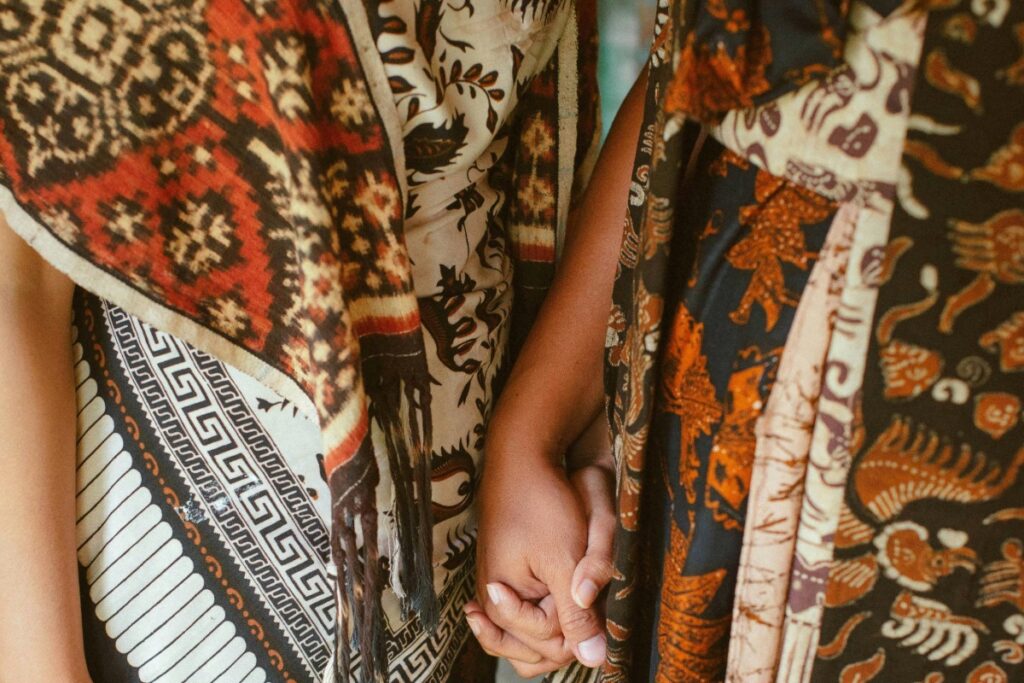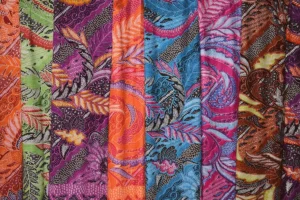Balinese traditional clothes are more than just outfits; they’re a reflection of Bali’s soul. On this island, daily life is deeply connected to tradition, religion, and art, and that connection is beautifully expressed through clothing.
Each piece is rich with meaning, showcasing intricate details, vibrant colors, and elegant ornaments that highlight the island’s creativity and identity. Depending on the ceremony or ritual, the styles and colors vary, showing just how diverse and culturally rich Bali truly is. Here are the meanings, styles, & etiquette of Balinese traditional clothes.
Table of Contents
ToggleKey Pieces of Balinese Traditional Attire
Women’s Attire
Balinese women’s attire is more than just clothing, it’s philosophy, elegance, and spirituality woven into every detail. Each piece of Balinese traditional dress carries a meaning that reflects beauty, humility, and balance with nature and the divine.
- Kebaya / Kebaya Bali
The top is called a kebaya, symbolizing elegance, modesty, and grace. A well-fitted kebaya shows humility and inner beauty. - Kamben (Songket Bali)
The bottom cloth, called kamben, is wrapped around the waist to the ankles. Often made with songket Bali, it represents the universe (Bhuwana Agung) and teaches women to honor purity and respect life. - Selendang
A sash tied around the waist, symbolizes self-control. Wearing a selendang reminds women to manage desires and emotions, keeping balance in their actions. - Prada Belt
A decorative sabuk prada wrapped over the selendang. This symbolizes strength, fertility, and protection of the womb, highlighting a woman’s sacred role as a giver of life. - Accessories & Flowers
Balinese women often adorn their hair with frangipani flowers, symbolizing purity, innocence, and beauty. These small touches complete the attire with devotion and elegance.
From temple ceremonies to Balinese wedding attire, this ensemble is more than just beautiful clothing, it embodies harmony between people, nature, and the gods.
Men’s Attire
Balinese clothing for men is just as meaningful and symbolic as women’s attire. Every element carries deep philosophy, connecting daily life with spirituality and Hindu Dharma values. Here are the main pieces of Balinese ceremonial attire for men and their meanings:
- Udeng Bali
The signature headband worn by Balinese men. The pointed fold at the front reminds men to keep their minds pure, focused, and always aligned with dharma (truth). - Baju (Shirt)
Usually white, the shirt represents purity and a clean soul, perfect for ceremonies and sacred rituals. - Kamen / Batik Sarong Bali
A long cloth wrapped from right to left around the waist. The batik sarong Bali symbolizes the universe (Bhuwana Agung) and respect for the earth as the source of life. - Saput
Worn on top of the kamen, the saput symbolizes self-control and wisdom. Covering the kamen reflects the need to manage desires and live in balance. - Belt (Sabuk)
The belt secures the kamen and saput in place, representing strength and protection. It serves as a reminder for men to stay disciplined and guard against negative behavior.
Together, these pieces of Balinese ceremonial attire are more than just clothing; they embody dignity, respect, and a man’s spiritual connection with the divine.
Colors & Symbolism
The Meaning of Colors in Balinese Traditional Clothing
When it comes to Balinese ceremonial attire, every color and detail carries deep meaning. It’s not just about style; it’s a reflection of nature, spirituality, and respect for the gods. This also ties into the temple dress code that Bali visitors often ask about.
- White: Symbolizes purity and truth. Linked to Iswara (Siva), this is the most common temple attire in Bali, especially for ceremonies.
- Yellow: Represents goodness and prosperity, often associated with Mahadeva and the west.
- Red: Signifies courage and life. Connected to Brahma, it symbolizes creation. Many travelers ask, “Is it okay to wear red in Bali?” The answer: yes, especially during ceremonies, since it’s a sacred and powerful color.
- Black: Stands for protection and balance, tied to Vishnu and the power of preservation.
So, what colors can’t you wear in Bali? Generally, bright ceremonial shades like white, yellow, red, and black are encouraged at temples, while overly flashy or revealing clothes are considered disrespectful.
Symbolism Behind the Attire
Beyond colors, the elements of temple attire Bali carry their own meanings:
- Gold Carving (Prada): Embellishments on belts and cloth symbolize wealth and majesty.
- Folds & Wraps: The way kamen or saput are tied shows respect and balance. For example, the upward fold of the udeng (men’s headband) reflects focus on God.
- Floral Touches: Frangipani (jepun) flowers represent beauty and purity, often worn during ceremonies as a tribute to the divine.
In essence, every piece of Balinese ceremonial attire, from color to ornament, acts as both clothing and prayer, a beautiful harmony of culture, faith, and philosophy.
When & How to Wear
When Should You Wear Balinese Traditional Clothing?
Wearing Balinese ceremonial attire isn’t just about tradition, it’s a way of showing respect. The most important time is when following the temple dress code Bali.
Anytime you step into a temple, you’re expected to wear proper temple attire Bali. Don’t worry if you don’t own any; most temples and nearby shops rent full sets for a small fee.
You’ll also see locals (and visitors) dressed in traditional outfits during big religious festivals like Galungan. Some travelers even wear Balinese textile pieces such as geringsing or colorful kebaya for photo sessions in temples or rice fields; it’s both cultural and Instagram-worthy.
How to Wear Balinese Traditional Attire
Putting on Balinese ceremonial attire is simpler than it looks, and rental shops will happily guide you.
For Men
- Kamen: Wrap the long cloth around your waist, below the knees.
- Saput: Layer a decorative kerchief over the kamen.
- Shirt & Udeng Bali: Finish with a white shirt and the iconic udeng (headband) for a polished look.
For Women
- Kamen: Wrap neatly around the waist, keeping it modest.
- Kebaya Bali: A fitted kebaya blouse adds elegance.
- Shawl: Tie a shawl (selendang) around the waist for balance and symbolism.
Extra Tips
- Renting Made Easy: Complete outfits are available at low prices near temples.
- Ask for Help: Staff or vendors are glad to show you the right way to tie a kamen or udeng.
- Respect is Key: While wearing temple attire Bali, always behave politely—it’s as much about attitude as it is about the outfit.
Balinese traditional clothes are far more than just ceremonial outfits—they are living symbols of harmony, spirituality, and respect for tradition. From the elegant kebaya Bali to the symbolic udeng Bali, every piece carries a story that reflects the island’s deep connection to faith, nature, and community life.
If you want to dive deeper into the meaning, etiquette, and beauty behind Balinese traditional clothes, check out Insight Bali—your best guide to explore culture, traditions, and unforgettable experiences on the Island of the Gods.






